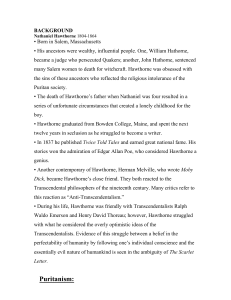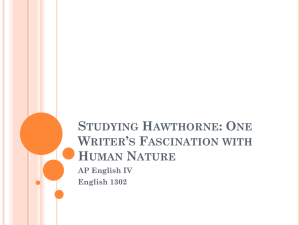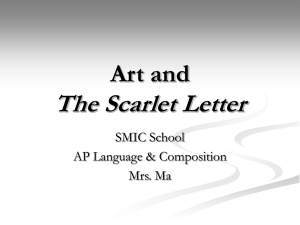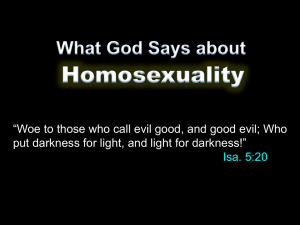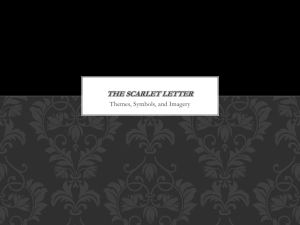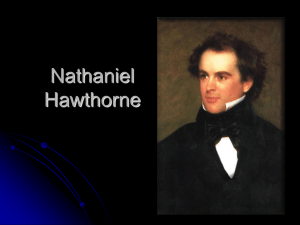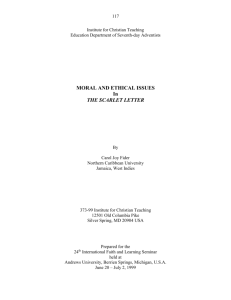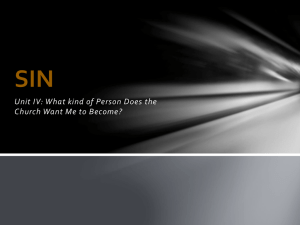The Scarlet Letter Background
advertisement
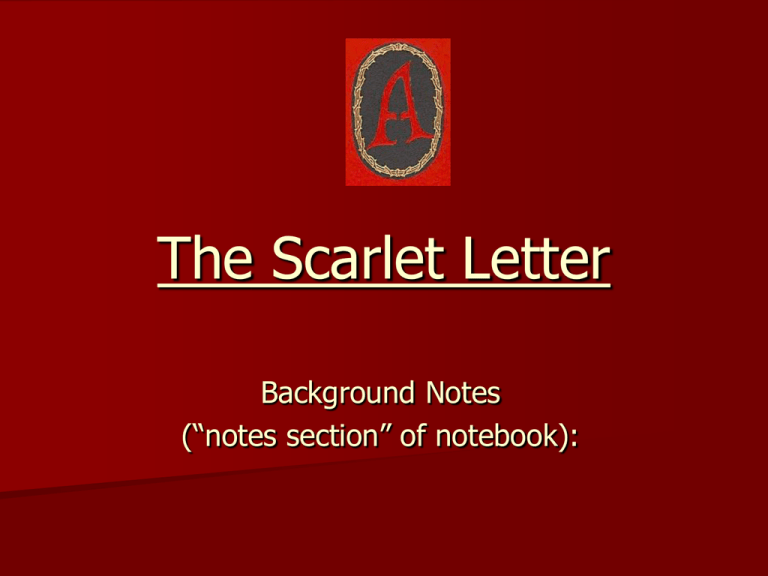
The Scarlet Letter Background Notes (“notes section” of notebook): Nathaniel Hawthorne I. Background on Nathaniel Hawthorne 1804-1864 (Born on July 4th) Born in Salem, Massachusetts His ancestors were wealthy, influential people. – William Hathorne – John Hathorne: presided over the Salem witch trials in 1692 His father died of yellow fever when he was four years old Hawthorne, his mother, and his sisters lived with his mother’s relatives after his father’s death He graduated from Bowdoin College in Maine in 1825 E. He returned to Salem where he struggled as a short story writer for 12 years F. In 1842, he married Sophia Peabody G. He published The Scarlet Letter in 1850, which finally brought him recognition as an author H. He died on May 16, 1864 in Plymouth, New Hampshire II. Hawthorne’s Literary Times A. Wrote during the Romantic Period 1. return to nature 2. belief in goodness of humanity 3. rediscovery of artist as a supremely individual creator 4. exaltation of the senses and emotions over reason and intellect Example of art from the Romantic Period The Lady of Shallot (1888) B. The Romantic Period lasted from 1830-1865 C. Literary contemporaries: Emerson, Thoreau, Melville, Stowe, Poe, Whitman D. The Scarlet Letter is considered a piece of American Romantic literature because it is set in a remote past (the Puritan era 200 years prior to Hawthorne’s time) and because it deals with the interior psychology of individual characters E. Revolt against rationalism/logic The Scarlet Letter—Themes Civil law versus Natural law The nature of sin and the effects of sin on the individual In The Scarlet Letter, Hawthorne analyzes the effect of one sin on the four main characters who are closely intertwined because of that sin (Hester, Pearl, Dimmesdale, Chillingworth) The individual’s relationship to society The Scarlet Letter—Setting Puritanism in the Massachusetts Bay Colony, 1642 The Scarlet Letter has unity of place. All action occurs in the center of Boston and the outskirts of this village. Accurate historical references are made to the actual governors, ministers, and practices of the Massachusetts Bay Colony of 1642-1650. NOTE: Hawthorne did not live during that time and was not a Puritan. Hawthorne wants the reader to react to these attitudes. III. Historical Commentary Puritans 1. A religious group that migrated from England to the Massachusetts Bay Colony in New England in the early 1600s 2. Believed in a “pure” interpretation of the Bible which did not include some of the traditional practices of the Church of England 3. Religion and government were closely intertwined 4. Ministers counseled the magistrates in all affairs concerning the settlement and its citizens 5. The Puritans had strict rules against theatre, religious music, sensuous poetry, and frivolous dress 6. Remember: The Puritans did not seek religious freedom for ALL; they still persecuted and banished individuals whose beliefs were different from their own 7. People were completely INTOLERANT of sin. They believed that any sin committed in the community would cause God’s wrath to be visited on them. An illness or misfortune would show God’s disapproval. 8. Puritans looked for sins that had been committed in the community so that the sin could be brought out in the open and the members of the community could express their scorn for that sin. 9. Puritan theology valued hard work. Idleness was an invitation to sin. IV. Themes A. Alienation B. Appearance versus reality C. Breaking society’s rules D. Private versus public life E. Effects of revenge V. Religious Terms A. repentance: deep sorrow for a sin B. preternatural: out of the ordinary; supernatural C. contrition: sorrow for a sin, with a sincere desire to atone for it (religious terms, contd.) D. penance: punishment for a sin E. atonement: to make amends for a sin F. penitence: the state of being regretful for sinning VI. Symbols A. B. C. D. E. the color black the forest the brook the rosebush Indians F. G. H. I. J. Hester’s clothing Pearl’s clothing Pearl’s name the meteor golden embroidery on the “A” VII. Style (paraphrase!) Hawthorne focuses his attention on the problem of evil and the NATURE OF SIN. He is not a moralist, but like a psychologist, he analyzes the inner world of the human mind and heart. In TSL, he analyzes the effects of ONE sin on the four main characters who are closely intertwined because of that sin. Essential Question What is a sin? Is a crime against civil law necessarily a crime against moral law?


